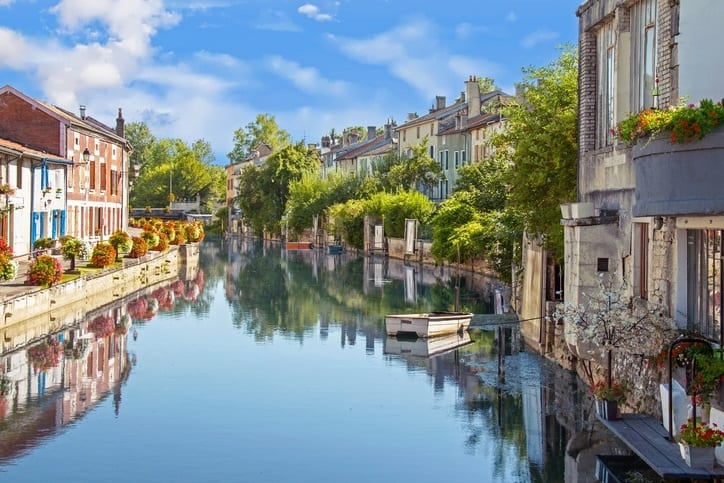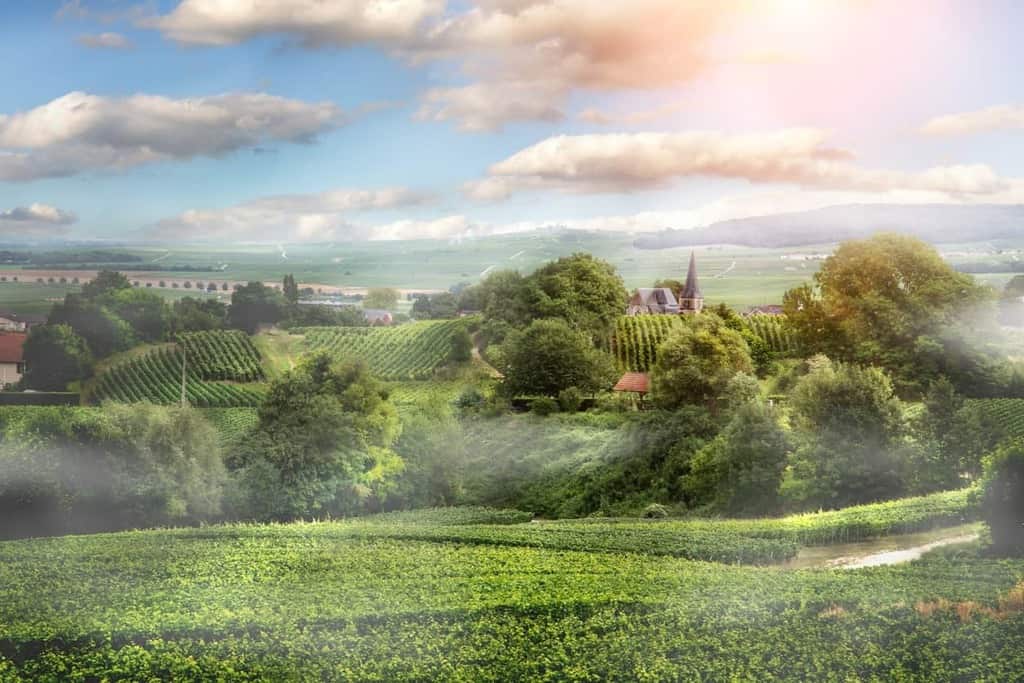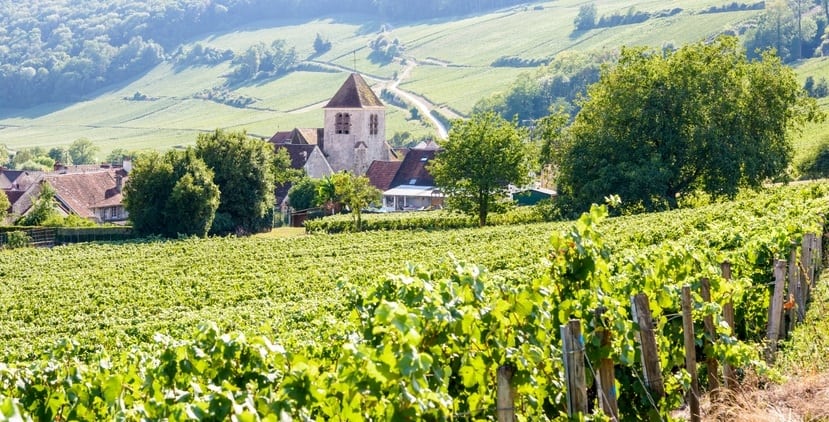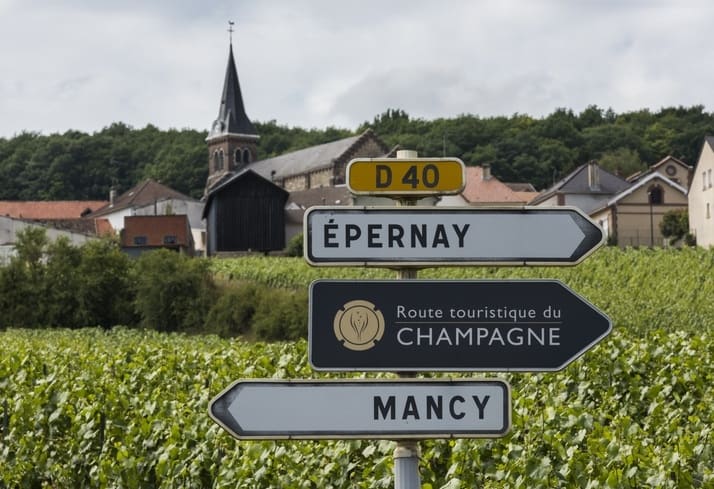Discover The Champagne Region of France
Last Updated on March 12, 2023.
Champagne. The mere mention evokes memories of celebration, but how did this spectacularly fizzy wine come to be? Common folklore credits Dom Perignon with inventing the sparkling wine that we’ve come to love today. In truth, the Benedictine monk was not a master of the bubbly, but he did make several significant contributions in transforming what was once a region that made extremely tart wines with only a slight fizz into the world’s most renowned sparkling wine.
The path to modern day Champagne must start with a word on its climate. Champagne lies on the northernmost limit of vine, growing with an average temperature of only 50 degrees Fahrenheit. This is key because in the past, the wines were made in the fall and the cold winter temperatures would temporarily pause fermentation, only for it to begin fermenting again come spring resulting in bubbles. At the time this was frustrating and somewhat frightening for the Champenois winemakers.
Further north, the Industrial Revolution was beginning in Britain, where glass was more and more readily available. British merchants would bottle the wine shipped in barrels from Champagne, and began adding sugar to the bottles to feed the British sweet tooth. Little did they know, that added sugar was then further fermented in the bottle producing more CO2 that was trapped in the bottle, giving it the signature celebratory pop. Eventually King Louis XV caught on to the brilliance of this and allowed Champagne to ship their wines in glass bottles. This, and further improvements since, all set the stage for how Champagne is made today.
MAKING CHAMPAGNE
- Step 1: Make the Base Wine
- The Champagne method starts exactly like any other wine, still wine is made from three possible grapes: Chardonnay, Pinot Noir, and Pinot Meunier. It is, however, very acidic and low in alcohol as these will adjust later.
- Step 2: The Assemblage
- Most Champagne is a blend of multiple wines made from different grapes, vineyards, and vintages. This is not always the case, but often it is.
- During the assemblage the winemaker decides what the blend will be, and puts the wines made in step one together.
- Step 3: Secondary Fermentation (making the bubbles)
- After the blend is assembled, the wine is bottled with a mixture of yeast and sugar (the liqueur de tirage).
- The bottle is then sealed and, over time, the yeast converts the sugar (a secondary fermentation) into a small amount of alcohol and CO2 which is trapped in the bottle, creating the bubbles.
- Step 4: Sur Lie Aging
- Once the secondary fermentation is complete, the yeast cells gradually break down in a process called autolysis.
- Sur Lie Aging means resting the wine on the lees (the spent yeast cells).
- In Champagne, it’s legally required to age on the lees for 12 months for non-vintage Champagne, and for vintage Champagne, 36 months is required. Many producers rest their wines on the lees even longer than this though.
- Sur Lie aging adds a creamier texture, and flavors/aromas of freshly baked bread and a nutty quality to the wine.
- Step 5: Riddling (Remuage)
- After sur lie aging, the lees must be removed or else the wine will have sediment and be cloudy. This is done by gently turning the bottle over and over to gradually to move the lees into the neck of the bottle.
- Step 6: Disgorging (Dégorgement)
- After the sediment has collected in the neck, the neck of each bottle is frozen in an ice bath and the yeast is ejected.
- Step 7: Dosage
- After disgorging, the liqueur d’expedition (a mixture of wine and sugar) is added to the bottle, determining the sweetness level.
- Driest to Sweetest: Brut Nature (0-3 g/L), Extra Brut (0-6 g/L), Brut (0-12 g/L), Extra Dry (12-17 g/L), Sec (17-32 g/L), Demi-Sec (32-50 g/L), Doux (50+ g/L).
- Step 8: Aging in Bottle
- The Champagne is then allowed to rest for a final period of aging, known as post-disgorgement aging, where the flavors and aromas of the wine continue to evolve and develop until it is ready to be enjoyed.
CHAMPAGNE SUB-REGIONS AND CLASSIFICATION SYSTEM
In Champagne, there is one all-encompassing appellation: Champagne AOC. It is, however, divided into five sub-regions: the Aube (Côte des Bar), Montagne de Reims, Côte des Blancs, Côte de Sézanne, and the Vallée de la Marne. Legally, any sparkling wine sold outside of the Champagne region cannot say Champagne on it. Other sparkling wines made in France are referred to as crémant, i.e. Crémant de Bourgogne.
The five sub-regions are further divided into 320 villages. Each village is classified as either Grand Cru (Great Growth), Premier Cru (First Growth), or Cru. There are 17 Grand Cru and 42 Premier Cru villages; all 17 Grand Cru are located in Montagne de Reims and the Côte des Blancs. Both of which are rich with chalky-limestone soils that reflect the sunlight up to the grapes, helping them ripen, and have good drainage.
Furthermore, there are three sub-types of Champagne you may come across: Blanc de Blancs, Blanc de Noirs, and Rosé. Blanc de Blancs (white wine from white grapes) are made solely from the Chardonnay grape. Blanc de Noirs (white wine from black grapes) are made solely from the red grapes Pinot Noir and Pinot Meunier, but the resulting wine is still white. Finally, Rosé Champagne can use any of the three permitted grapes, but a small amount of still Pinot Noir is added into the bottle before the secondary fermentation.
Additionally, there are in fact non-sparkling (still) wines made in Champagne, and they are sold as Coteaux Champenois.
Champagne Grape Varieties:
Champagne Sub-Regions:
- Aube (Côte des Bar)
- Montagne de Reims
- Côte des Blancs
- Côte de Sézanne
- Vallée de la Marne
Written By Jordan Whitney
Jordan Whitney is a certified sommelier and wine writer based in Chicago, IL. He is currently the Assistant Sommelier at Proxi in Chicago’s West Loop.
How To Visit Champagne France
A Wine Lover’s Guide To Visiting Champagne France
Two Day Champagne Itinerary: Explore Champagne-Ardenne France




[…] made only in Reggio Emilia and Modena, Italy, similar to how sparkling wine can only be called inch champagne inches if it comes from the Champagne region of France. Made from grapes, balsamic is processed […]
[…] of Bordeaux, the historic Pinot Noir expressions in Burgundy, the prestigious sparkling wines of Champagne, down to the beautiful Rosés of Provence, France pretty much makes them […]